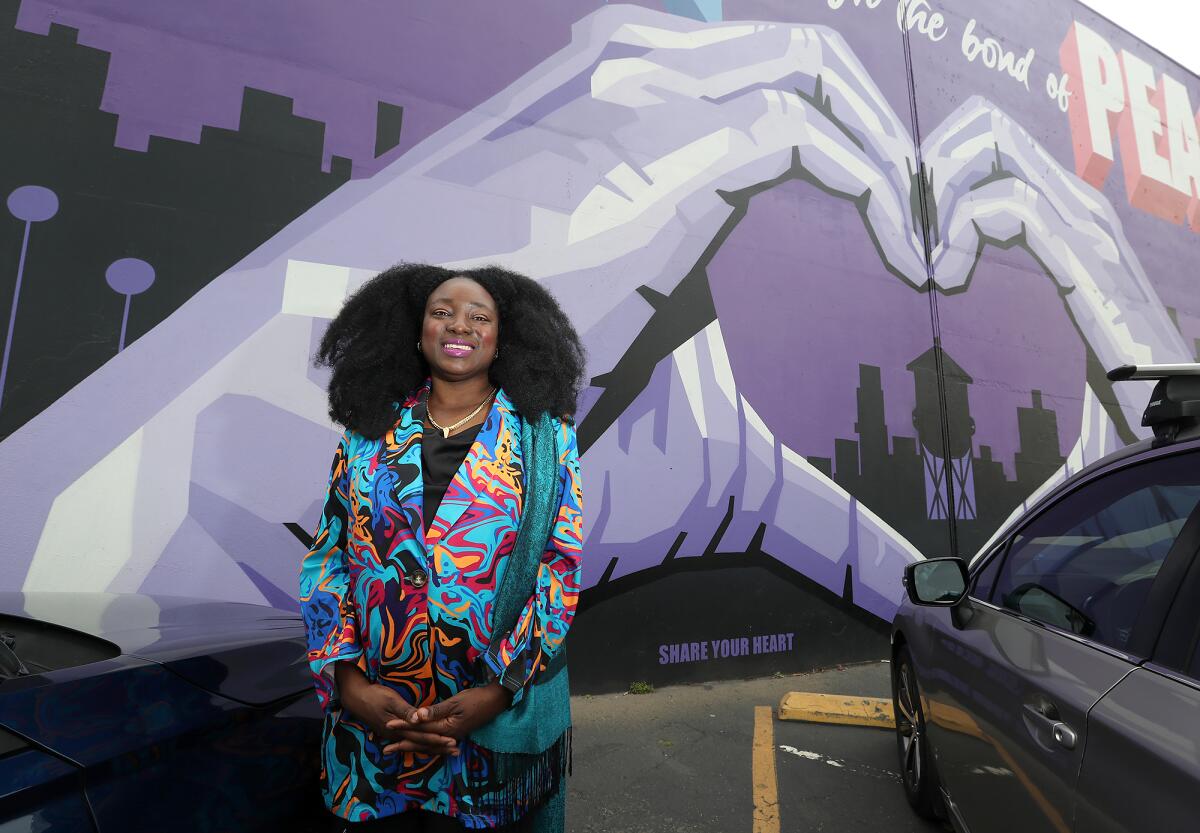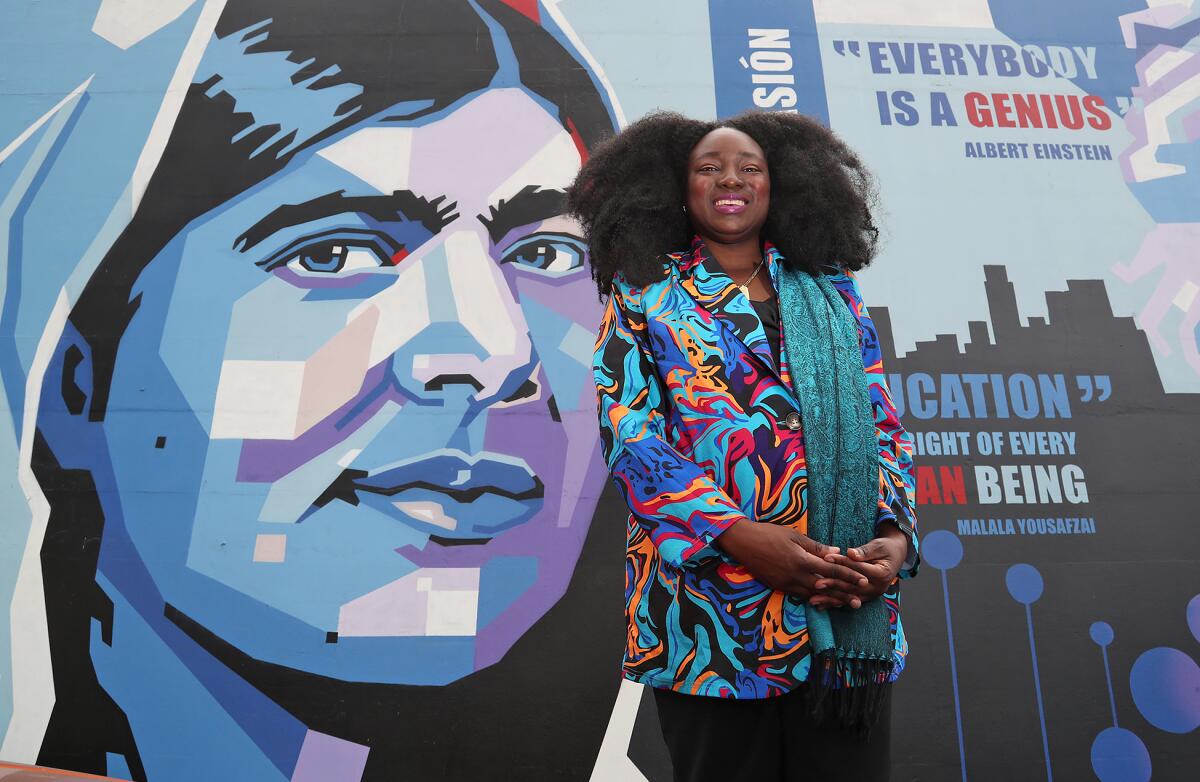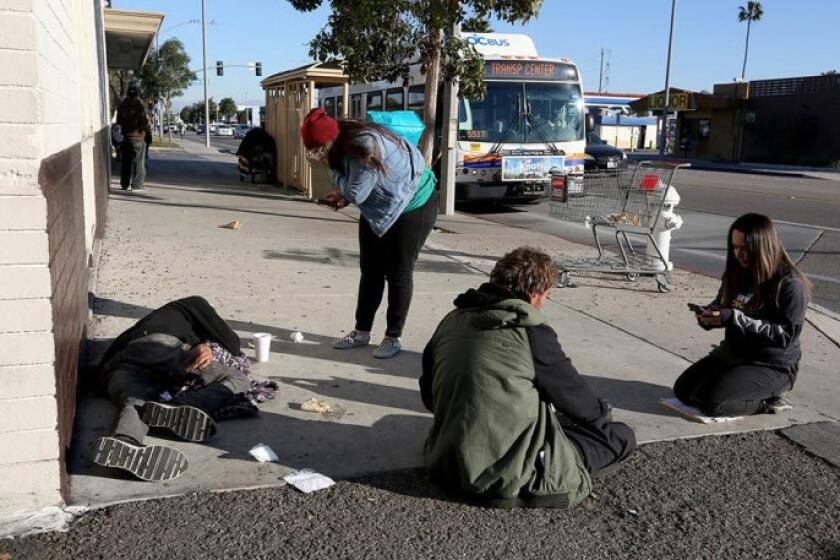Santa Ana bears the brunt of pandemic inequities. She’s tasked with guiding its recovery

- Share via
With another winter wave of coronavirus crashing over Orange County, Santa Ana is, once again, carrying the burden of inequity.
As of Jan. 19, four of the city’s ZIP codes are posting test positivity rates above the county average of 28%, with the highest among them topping it by 10 percentage points.
Santa Ana, a majority Latino city with a sizable immigrant population from Mexico, has disproportionately suffered the pandemic’s hardships even before the arrival of the highly infectious Omicron variant.
When last winter’s wave began to surge, the city’s share of positive tests doubled the county average at one point. This time around, the disparities aren’t as stark, but they remain characteristic of Santa Ana’s coronavirus experience just the same.
In taking an innovative approach, Santa Ana recently hired Dr. Bernice Rumala, a former United Nations consultant in Iraq, to help close those gaps while recovering from the pandemic. Working out of the city manager’s office, Rumala now serves as the program director for Health Equity and Literacy in OC (HEAL-OC).
She arrives with an array of accolades and accomplishments.
Rumala holds a doctorate and three master’s degrees from Columbia University. She’s also served as a Fulbright and Harvard research fellow. In addition to consulting for the U.N., Rumala has worked across the nation and globe on issues of public health and education.
“My life’s work has been rooted in addressing inequities,” said Rumala, an O.C. resident. “I’m a person with lived experiences of inequities, including having faced systemic racism.”
Santa Ana Mayor Vicente Sarmiento and the City Council approved Rumala’s position in December.
“As the new program director, Dr. Rumala brings innovative leadership and vision to address health equity and equity challenges within Santa Ana and Orange County as a whole,” Mayor Sarmiento said. “Her multidisciplinary expertise across different local, national, and international sectors is what is needed. Dr. Rumala’s fresh perspective in partnership with communities who are invested is an important step for health equity.”
The 2022 Point in Time count will now be held in the last 10 days of February.
The initiative follows Santa Ana being awarded a two-year $4-million federal Health Equity and Literacy grant this summer. It’s part of a $250-million effort from the U.S. Department of Health and Human Services Office of Minority Health to boost vaccination rates and access to accurate COVID-19 information in hard hit communities of color.
A majority of the funding is being awarded by the city to local community organizations and institutions that collaborated on the grant proposal.
“Over time, what is recovery going to look like in these communities?” said Nancy Mejia, chief program officer at Latino Health Access, one of the awardees. “Moving forward, we thought this would be a great opportunity to invest in an equity-driven approach where we’re all coming together.”
The Coalition of O.C. Community Health Centers, Latino Health Access, Orange County Asian and Pacific Islander Community Alliance and UC Irvine have worked collaboratively during the pandemic on producing data on inequity, outreaching to communities of color and running mobile vaccine and testing clinics.
They will continue to do so with more resources at their disposal as part of HEAL-OC.
“This is a unique opportunity — as part of a municipality, academic and community partnership — to really address a lot of these issues from the root causes,” Rumala said. “We know that many of these inequities existed before the pandemic. It just became further highlighted during it.”

According to the Orange County Health Care Agency, Latinos comprise 37.5% of the confirmed cases countywide and 35% of the population. By comparison, white residents account for 29% of cases while being 38.6% of the population.
The disparities don’t stop there.
While whites and Latinos account for an almost equal number of COVID-19 deaths, the Latino population in the county is much younger on average. Only 15.4% of the county’s seniors 65 and older are Latino, while 60.4% of that same demographic are white.
More than a year after the vaccination campaign started in O.C., rates among Latinos continue to lag behind. Though fully vaccinated rates for Latino seniors are more commensurate with their share of the elderly population at 76%, they trail far behind when considering those eligible for the vaccine under 65 years of age at just 53%.
Latinos are also less likely than whites to have had a booster dose.
“The root of the inequity has to do with engaging the public with the right information,” Rumala said. “I’ve already participated in some of the vaccination outreach campaigns in some of the neighborhoods. What’s most effective is engaging with community allies and ambassadors who can help spread the health literacy messaging and the importance of vaccination.”
Health literacy in the context of Rumala’s work encompasses a host of issues including language barriers, digital divides and misinformation online.
“We have to acknowledge that because of the legacy of inequity, it shouldn’t be a surprise that the vaccination numbers look the way that they do,” Mejia added.
Together with Mayor Sarmiento, Rumala also co-chairs the Health Equity, diversity, inclusion, and Anti-Racism Taskforce (HEART), the first of its kind for an O.C. city, which formally launched on Jan. 4. The need for such a task force arose from listening sessions held under the HEAL-OC effort.
“To have a woman of color leading this initiative is very important to us,” Mejia said. “We’re all really excited to have her on board as the face of the city and the collaborative.”
Rumala’s only been on the job for about a month but is looking to bring the same approach to Santa Ana as she did when working with women displaced in Iraq during the height of the war on ISIS.
That means putting those most affected by inequities front and center along the way of finding solutions.
The task force is looking to embark on a process that includes capacity building trainings and finding a common understanding of what equity means as well as what it would look like emerging from the pandemic. It will take a multiagency approach in looking for ways to improve services to the community.
With health equity at its core, HEART will also have a role in recommending public policies.
Prior to coronavirus, advocates in Santa Ana pushed for more park space and solutions to overcrowded living conditions that affected public health in the form of respiratory diseases, obesity, diabetes and mental health. Working-class residents often had to choose between rent and the expense of health insurance.
Those very same living conditions, advocates argued, helped lead to Santa Ana becoming the Orange County epicenter of infection from the onset of the pandemic.
Whatever the task force formulates as solutions throughout the next two years remains to be seen. Rumala promised that it won’t be a Band-Aid approach that simply checks off boxes.
“This is a time for change,” she said. “This is a time for systems transformation.”
All the latest on Orange County from Orange County.
Get our free TimesOC newsletter.
You may occasionally receive promotional content from the Daily Pilot.





